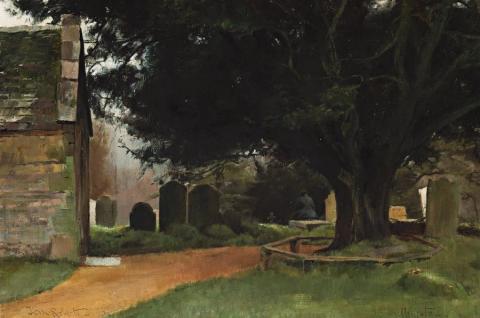CHURCHYARD AT SHILLINGSTONE, 1884
TOM ROBERTS
oil on canvas
30.5 x 45.5 cm
signed and dated lower left: Tom Roberts – Jan 84
inscribed lower right: at Shillingstone
inscribed on paper label verso: Chillinstone [sic] Churchyard
framer's label attached verso: J. & T. Thallon, Melbourne
Dick Roberts, the artist's brother
Thence by descent
Private collection, Melbourne
Joseph Brown Gallery, Melbourne
Private collection, Queensland
Deutscher~Menzies, Melbourne, 8 September 2004, lot 40
Private collection, Melbourne
Spring Exhibition, Joseph Brown Gallery, Melbourne, 1–10 September 1980, cat. 54 (illus. in exhibition catalogue)
Tom Roberts, Art Gallery of South Australia, Adelaide, 5 October – 17 November 1996;
Tasmanian Museum and Art Gallery, Hobart, 30 November 1996 – 27 January 1997;
National Gallery of Victoria, Melbourne, 12 February – 6 April 1997;
Art Gallery of New South Wales, Sydney, 19 April – 1 June 1997;
Art Gallery of Western Australia, Perth, 11 June – 27 July 1997, cat. 3 (label attached verso)
Spate, V., Tom Roberts, Lansdowne Press, Melbourne, 1978, pp. 24–25, pl. 1 (illus., as 'Churchyard, Chillingstowe (At Chillingstowe)') Topliss, H., Tom Roberts 1856–1931: A Catalogue raissoné Radford, R. (ed.), Tom Roberts, Art Gallery of South Australia and Art Exhibitions Australia, Adelaide, 1996, pp. 23, 193 (illus.) McQueen, H., Tom Roberts, Macmillan Publishing, Sydney, 1996, p. 126
Tom Roberts was born in Dorset, Thomas Hardy country, where his father Richard Roberts was editor of the Dorset County Chronicle. Following Richard's early death in 1868, Tom's widowed mother and family migrated to Australia, leaving Dorchester behind. The county continued to have an appeal for the young artist, who visited there in early 1884 while studying at London's Royal Academy Schools. Its attraction continued into later years, seen in the seasonal paintings of spring and autumn in Dorset of c1910-14, and A Windy Day, Dorset of the early twenties. Churchyard at Shillingstone is a rare work from his first visit, the choice of subject being a resting place for many memories.
The stone Church of the Holy Rood, dating from the twelfth century, lies just outside the village of Shillingstone in the Blackmore Vale, north Dorset. Working directly in a realist style, Roberts captured not only the likeness of the scene but also explored its symbolic possibilities. The season of winter speaks of the end of our days. The atmosphere is moist by feel and hushed in mood. Similarly, the play of light and shade takes on a dual role. Rays of sunlight highlight tombstones and show others in silhouette. Off centre, a woman sits attired in black, meditating, embraced by tranquillity. Her back view expresses a privacy that is deeply personal. A more recent grave decked with fresh flowers sits in the immediate foreground, right. The return to Dorset surely prompted Roberts's recollections of his father. Virginia Spate, when writing about our painting in her pioneering study of Roberts, drew attention to his use of light 'in a symbolic way (with a ray falling on the grave) in a manner typical of the humanised English landscape. He never again used light in such an overtly symbolic or sentimental way', she added, 'but he was always aware of its emotive value.1
The French painter Jules Bastien-Lepage (1848-84) was widely celebrated at this time, his influence being strongly felt in the early work of Roberts and Frederick McCubbin. While McCubbin embraced his naturalism with an almost literal truth to nature, Roberts drew upon his technique to achieve his own ends. As Spate observed, 'the tonalities of Bastien Lepage seemed right for the misty greyness of an English churchyard in winter'.2 Of Roberts's other English paintings from this time, London subjects aside, it has been suggested that an untitled landscape (Topliss 29) offers another view of the same churchyard at Shillingstone; he also painted Churchyard at Hampstead Heath, 1884 (Topliss 37), said to be drawn from John Constable's tomb.3 For Roberts, it was a time of nostalgia mixed with sentiment.
1. Spate, V., Tom Roberts, Lansdowne Press, Melbourne 1978, p. 24
2. Ibid.
3. Topliss, H., Tom Roberts 1856-1931: A Catalogue Raisonne, Oxford University Press, Melbourne, 1985, vol. 1, cats. 29 and 37, pp. 86, 87; vol. 2, illus. pl. 7 and pl. 9
DAVID THOMAS
